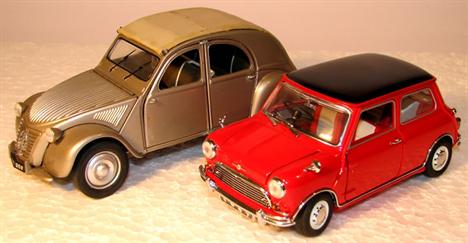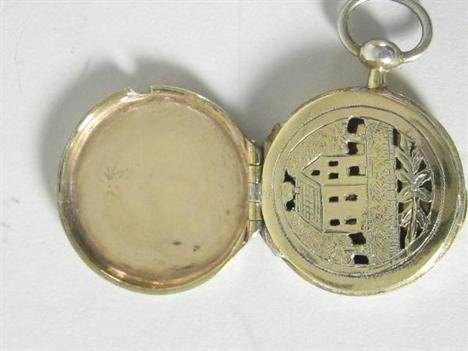A Chinese blue and white export plate simply painted with flower forms within double line border and blue line rim, etched and stamped with character marks to well and to underside, 19cm diameter; together with a Japanese saucer dish, painted with flowers and masks and scale ground, 21cm diameter.
We found 216134 price guide item(s) matching your search
There are 216134 lots that match your search criteria. Subscribe now to get instant access to the full price guide service.
Click here to subscribe- List
- Grid
-
216134 item(s)/page
A PAIR OF SITZENDORF PORCELAIN FIGURAL CANDLESTICKS, allegorical of Summer and Autumn, and modelled as pairs of scantily draped children, with a sheaf of corn and basket of flowers, and a goblet and bowl of fruits, with flower encrusted rococo scroll sticks on gilt scale and pink and blue scroll bases, marked in blue, 12" high
A Fine French Wall Barometer. The case veneered in diagonally grained kingwood veneers enriched with gilt bronze Rococo mounts cast with scrolls of crested foliage and incorporating a thermometer with hand painted scale and barometer dial inscribed Barométre selon Toricelly. 45 ins (115 cms) in height.
George III mahogany bracket clock by Hardeman & Son of Bridge. The painted dial with Roman numerals and strike/silent above twelve. The twin fusee movement striking on a bell, signed to the engraved back plate, the pendulum engraved with regulation scale. The case with brass inlay, fish scale fretwork panels and ring drop handles to each side, 50cm high.
A Derby porcelain figure of Britannia circa 1770, in a gilt fish scale bodice and enamelled dress with drapery, before a bocage trunk, a shield to her side and a lion and martial trophies to her feet, raised on a scroll moulded base picked out in gilt, unmarked, 14.25in (36cm) high, lacks trident, some losses, hairline cracks and old repairs.
A rare wind direction indicator with rain gauge, W.N. Last, Bury St. Edmunds, early 19th century, the 10 inch circular glazed silvered register engraved to represent a compass rose divided into 32 divisions and signed W.N. LAST, Bury St. Edmunds to centre, within turned surround above slender trunk inset with a glass cannister rain gauge with silvered vernier scale calibrated 0-3 inches and divided 1-100, the base with two adjustment squares and curved underside (original linkages removed) 90cm high. Visit www.dnfa.com for condition reports
A rare George III satinwood mercury wheel barometer, Vecchio, Nottingham, early 19th century, the 10 inch rosette centred circular silvered register calibrated in inches beneath arched Fahrenheit scale mercury thermometer and hygrometer to the swan neck pediment, the rounded base with spirit level signed VECCHIO, Nottingham and setting pointer adjustment disc, the case with line inlaid borders to front edges, 107cm high. Probably by James Vecchio who is recorded in Banfield, Edwin BAROMETER MAKERS AND RETAILERS 1660-1900 as working in Nottingham circa 1810-30 Visit www.dnfa.com for condition reports
A fine and rare George III inlaid mahogany double tube or contra-barometer, Balthazar Knie, Edinburgh, dated 1800, the case with broken triangular pediment and parquetry inlaid chevron frieze above rectangular silvered scale inscribed MADE BY MR. KNIE, 1800 to lower centre, applied with visible syphon tube with bulb to top of mercury column on the right and to cistern end on the left, above which is an oil filled narrow bore extension tube against a scale calibrated in reverse 28 to 31 inches divided into hundreds and calibrated in tenths over this range, with the usual engraved annotations and sliding brass recording pointer, the whole within line inlaid and gilt cavetto moulded surround and behind glazed door, the base with inverted cavetto moulded foot, 114cm high. The development of the double tube barometer is generally attributed to Robert Hooke (1635-1703) who in 1668 demonstrated a related instrument to the Royal Society. By having bulbs at each end of the mercury filled cistern tube, relatively small movements within the mercury level would occur with changes in atmospheric pressure due to the increased surface area of the mercury within the bulbs in relation to the bore of the tube. However, by filling the narrow bore extension tube with a coloured oil on the syphon side, amplified movement will be observed. Due to the fact that the oil level will drop with increase in atmospheric pressure, the barometer scale and associated comments work in reverse, which is why this type of barometer is referred to as a "contra-barometer". A similar instrument by Knie is illustrated in Banfield, Edwin BAROMETERS Stick or Cistern Tube on page 209 alongside an example signed T. Thompson EDIN"r (which was sold in these rooms The Banfield Collection of Barometers Tuesday 4th September 2007 lot 185). Another comparable instrument by B. Brown of Edinburgh is illustrated in Goodison, Nicholas English BAROMETERS 1680-1860 page 102 which Goodison suggests could have been supplied to Brown by Knie. Visit www.dnfa.com for condition reports
A rare George III mahogany mercury dial barometer, Spear, Dublin, circa 1800, with ivory vase finial to the swan neck pediment above 7 inch square glazed silvered register calibrated in inches with the usual annotations and signed Spear 23 Capel St. DUBLIN to centre, with brass setting pointer adjustment disc to throat above arched mercury Fahrenheit scale thermometer to the slender trunk, the tablet shaped base with cavetto moulded underside, 101cm high excluding finial. Richard Spear is recorded in Banfield, Edwin BAROMETER MAKERS & RETAILERS 1660-1900 as working from 23 Capel Street, Dublin 1793-1809. Visit www.dnfa.com for condition reports
A Victorian rosewood sympiesometer, Joseph Hughes, London, mid 19th century, with stepped cavetto moulded pediment above glazed rectangular silvered scale applied with oil and hydrogen gas filled syphon tube against a Fahrenheit temperature scale with separate adjustable scale calibrated for the barometric inches, to the left is a Fahrenheit scale mercury thermometer, the plate is inscribed Joseph Hughes, London, Improved SYMPIESOMETER and has a sector for the rotating recording disc towards the lower left hand corner, 59cm high. Joseph Hughes is recorded in Banfield, Edwin BAROMETER MAKERS AND RETAILERS 1660-1900 as working from various addresses in London 1822-78. The sympiesometer was invented by Alexander Adie of Edinburgh in 1818 as an alternative to the standard marine barometer. The instrument works by measuring the relative atmospheric compression of hydrogen in the upper section of a syphon tube usually filled with almond oil. However, as hydrogen will expand and contract with variations in temperature, the pressure scale first needs to be calibrated against a temperature reading (from the thermometer placed next to the syphon tube) before the atmospheric pressure can be ascertained. The main benefit gained from using a sympiesometer rather than a mercury barometer whilst at sea is that it is less susceptible to the motion of the ship and easily calibrated for variances in temperature. Visit www.dnfa.com for condition reports
A Regency mahogany bowfronted cistern tube stick barometer, Dollond, London, early 19th century, with cavetto moulded caddy upstand above brass edged glazed rectangular silvered vernier register annotated and calibrated in inches and signed DOLLOND, LONDON to upper margin, the trunk with vernier adjustment squares and hygrometer above brass edged bowfronted mercury Fahrenheit and Reaumur scale thermometer flanked by ebony line inset edges above ebonised urn-shaped cistern cover to the shaped rectangular base with ebony line lozenge inlaid canted angles and cavetto moulded underside, 101cm high. Peter Dollond is recorded by Banfield as born 1730 and died 1820. He was the son of John Dollond, a Huguenot silk weaver, and started business as an optician at the age of twenty in 1750. He was joined by his father in 1752 until the latter`s death in 1761 and then by his brother, John, until his death in 1804. The family business was continued by Peter Dollond`s nephew, George Huggins, who subsequently changed his surname to Dollond. Peter Dollond was appointed optician to George III and the Duke of York and the workshop was renowned for producing high quality instruments. Visit www.dnfa.com for condition reports
-
216134 item(s)/page






























